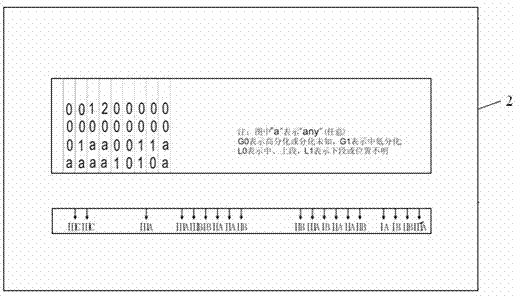Drawing-type scale device for esophageal squamous carcinoma TNM staging
An esophageal squamous, pull-out technology, applied in the field of medical clinical applications, can solve the problems of delayed treatment, inability to achieve curative effect, waste of time, etc., and achieve the effect of being convenient to carry around, easy to consult at any time, and easy to use
- Summary
- Abstract
- Description
- Claims
- Application Information
AI Technical Summary
Problems solved by technology
Method used
Image
Examples
Embodiment 1
[0023] see Figure 1-3 , a kind of international TNM staging scale device for esophageal squamous cell carcinoma of the present invention is composed of a rectangular hollow sleeve 1 with openings at both ends and a drawer plate 2 marked with staging results. The length and width of the hollow sleeve 1 are respectively 20cm and 12cm, pumping plate 2 is inserted into the hollow cover 1, its length and width are suitable for the hollow cover, and the first rectangular window 3 with a length and width of 16cm and 4cm and a length and width of 16cm and 4cm are respectively arranged on the front of the hollow cover 1. The second rectangular window 4 of 1 cm is provided with a semicircular notch 5 with a diameter of 15 mm in the middle of the opening of the central control sleeve, which is convenient for moving the drawer; on the back of the hollow sleeve 1, various classification variables of the seventh edition of TNM staging are printed The definition of is helpful for clinicians...
Embodiment 2
[0029] The method of use of the present invention: Step 1: According to the routine pathological report after the operation of esophageal squamous cell carcinoma, determine the corresponding tumor invasion depth (T), lymph node metastasis (N), whether there is distant metastasis (M), The situation of the five variables of differentiation type (G) and tumor location (L).
[0030]The second step: according to the variable situation determined in the first step, move the pumping board 2 to align the corresponding variable situation.
[0031] Step 3: directly read the staging indicated by the black arrow symbol, which is the postoperative staging result of the patient with esophageal squamous cell carcinoma.
Embodiment 3
[0033] see figure 1 , specific example 1, a 65-year-old male patient, endoscopy showed esophageal lesions 32cm away from the incisors. In 2012, Department of Thoracic Surgery, Zhejiang Cancer Hospital, underwent two-incision radical resection of right thoracic esophageal cancer + systematic lymph node dissection. Postoperative pathological report: 1. Esophageal plaque type (tumor body 1cm*0.6cm*0.5cm) well-differentiated squamous cell carcinoma, infiltrating into the muscularis mucosae. 2. (Perioesophageal) 1, (gastric) 2, (cardia) 3, (left stomach) 6, (left recurrent laryngeal nerve) 5, (subcarina) 6 lymph node chronic inflammation Accompanied by charcoal deposits in some lymph nodes. 3. Part of gastric tissue. Remarks: The upper and lower incision margins are negative. According to the postoperative pathological report of the patient, the clinician firstly determines the depth of tumor invasion, the submucosa is (T1), no lymph node metastasis (N0), no distant metastasis ...
PUM
 Login to View More
Login to View More Abstract
Description
Claims
Application Information
 Login to View More
Login to View More - R&D
- Intellectual Property
- Life Sciences
- Materials
- Tech Scout
- Unparalleled Data Quality
- Higher Quality Content
- 60% Fewer Hallucinations
Browse by: Latest US Patents, China's latest patents, Technical Efficacy Thesaurus, Application Domain, Technology Topic, Popular Technical Reports.
© 2025 PatSnap. All rights reserved.Legal|Privacy policy|Modern Slavery Act Transparency Statement|Sitemap|About US| Contact US: help@patsnap.com



